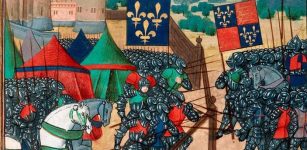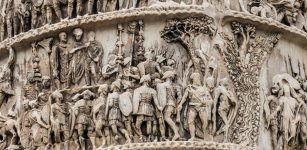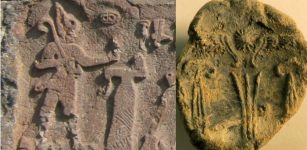Trung Sisters Of Vietnam: National Heroines That Stood Against Cruel Chinese Occupation Of Their Country
A. Sutherland - AncientPages.com - Two Vietnamese sisters - Trung Trac and Trung Nhi – are widely known in Vietnam as Hai Ba Trung (literally: ‘Two Ladies Trung’).
These two brave young warrior women lived between around 12 and 43 AD and in 39 AD and they led Vietnam in its first rebellion against China. The cruel acts committed by the Chinese rulers on their Vietnamese subordinates gave Trac and Nhi sisters motivation to fight. The Trung sisters had one goal - freeing the Vietnamese people from the Chinese domination of the Han dynasty.
The Trung sisters are national heroines. Credit: Adobe Stock - Rob Byron
The sisters were born in a military family and their father was a high official. They lived about 2,000 years ago, at a time when Vietnamese women really enjoyed the freedom that in later centuries, was forbidden.
They could inherit from their mothers; they could be traders, warriors, or even politicians. Growing up in a family with military traditions, the Trung sisters learned much from their mother who trained them in martial arts. They also improved their knowledge of waging war and looked at fighters who were refining their fighting skills.
The perfect moment to begin a war with a powerful occupant was about to come.
Love And Death In Life Of One Of The Sisters
One day, the prefect of the neighboring province and his son Thi Sach, visited the family Trung and Trac met Thi Sach, who already began a rebellion against the Chinese policy of forced assimilation of the Vietnamese people. The two fell in love and soon he asked for her hand.
They would fight together against the Chinese enemy. At that time a new, more tyrannical governor To Dinh took over the province. He demanded bribes, dramatically raised taxes on salt, and imposed new devastating taxes on the local peasants.
This was a kind of situation that in many countries and different epochs, usually led to violate protests and triggered a rebellion. The same happened in China.
Along with her husband, Trung Trac mobilized the local aristocracy to revolt. The governor suspected that Trac’s husband was the driving force behind the plot. Thi Sách. He arrested and executed him, additionally, hanging his dead body from the city gates as a warning to other rebels.
Sisters Trung Take Over The Mission
The sisters did not give up their battle; instead, they mobilized an army of eighty thousand troops consisting of young men and a large number of women. Thirty-two generals in the Trung army were women, including the sisters’ elderly mother, who - as legend says - trained the sisters in the arts of war.
The Trung sisters had one goal - freeing the Vietnamese people from the Chinese domination of the Han dynasty. The statue of Hai Ba Trung in the Suoi Tien Amusement Park, which is located at the 9th District, Ho Chi Minh City, Vietnam. Credit: Public Domain
The Trung sisters and their army were successful; they drove the Chinese from Vietnam and formed a new state that stretched from Hue in the south into southern China. The grateful people titled the two ladies "the queens of the Vietnamese nation."
For the time being, Vietnam was free; the Trung sisters abolished taxes imposed by the Chinese and made the peoples’ life much easier. They ruled unchallenged but not for long because the Chinese did not forget the defeat.
In 41 CE, the Chinese emperor of the Han Dynasty, Guang Wu Di (5 BC-57 AD) sent one of his best military generals, Ma Yüan, to deal with troublesome Vietnam and reconquer it.
For some time, the sisters managed to defend their borders against the Chinese, but eventually, they were stunned by China’s military and financial superiority.
One legend says that the Chinese come up with a curious plan – sending … naked soldiers to battle against the sisters and their army.
Many Versions Of Trung Sisters’ Fate
The Trungs fought their final battle in 43 AD, in the vicinity of the modern city of Hanoi. There are different accounts concerning the fate of the Trung sisters, both in Vietnamese and Chinese sources. One source reports they died fighting after they were deserted by their companions. The ‘Book of the Later Han’ (history of the Han dynasty from 6 AD to 189 AD informs that they were decapitated by the general Ma Yuan, who sent their heads back to the Han capital.
Meanwhile, a legendary version of their story, tells that Trac and Nhi became ill and disappeared in the sky, and yet another says they took their own lives by drowning.
Trac and Nhi knew they could not defeat the huge military forces from China. They were also aware that continuous fighting would mean certain death.
To avoid ridicule and save their honor, the sisters most probably decided to commit suicide by jumping to a river, according to one historian.
To this day, the Trung sisters are the nation’s heroines, praised in literary works. Their names are used to name streets, schools, hospitals, and countless other institutions. Many temples are dedicated to Trac and Nhi, and each year in February, a special holiday commemorates their deaths. The Vietnamese people remember the sisters and some say that if it were not for the courageous resistance that the sisters set for the Chinese invaders, the Vietnamese people would today not exist.
Written by – A. Sutherland - AncientPages.com Senior Staff Writer
Updated on August 1, 2021
Copyright © AncientPages.com All rights reserved. This material may not be published, broadcast, rewritten or redistributed in whole or part without the express written permission of AncientPages.com
Expand for referencesMore From Ancient Pages
-
 On This Day In History: Battle of Castillon Ended ‘Hundred Years’ War – On July 17, 1453
News | Jul 17, 2016
On This Day In History: Battle of Castillon Ended ‘Hundred Years’ War – On July 17, 1453
News | Jul 17, 2016 -
 Ancient Pottery Found On The European Atlantic Coast Sheds Light On Cooking In The Bronze Age
Archaeology | Jan 16, 2024
Ancient Pottery Found On The European Atlantic Coast Sheds Light On Cooking In The Bronze Age
Archaeology | Jan 16, 2024 -
 Archaeological Sites At Risk From Coastal Erosion On The Cyrenaican Coast Of Libya
Archaeology | Apr 15, 2023
Archaeological Sites At Risk From Coastal Erosion On The Cyrenaican Coast Of Libya
Archaeology | Apr 15, 2023 -
 Satellite Images Reveal Huge 4000-Year-Old Military Network In Syria
Archaeology | Dec 23, 2017
Satellite Images Reveal Huge 4000-Year-Old Military Network In Syria
Archaeology | Dec 23, 2017 -
 Home Of The Gods – The Return Of The Gods – Part 3
Civilizations | Jun 14, 2018
Home Of The Gods – The Return Of The Gods – Part 3
Civilizations | Jun 14, 2018 -
 Impressive Column Of Emperor Marcus Aurelius – War Monument From Ancient Rome
Featured Stories | Jul 6, 2017
Impressive Column Of Emperor Marcus Aurelius – War Monument From Ancient Rome
Featured Stories | Jul 6, 2017 -
 Yokai Kitsune: Charming And Cunning Liar With Double Nature In Japanese Folklore
Featured Stories | May 22, 2020
Yokai Kitsune: Charming And Cunning Liar With Double Nature In Japanese Folklore
Featured Stories | May 22, 2020 -
 Mahabharata And Ramayana – Two Major Sanskrit Epics Of Ancient India
Featured Stories | Jul 12, 2021
Mahabharata And Ramayana – Two Major Sanskrit Epics Of Ancient India
Featured Stories | Jul 12, 2021 -
 3D Reconstruction Of ‘Lost Chapel’ Of Westminster Palace
Archaeology | Oct 9, 2017
3D Reconstruction Of ‘Lost Chapel’ Of Westminster Palace
Archaeology | Oct 9, 2017 -
 Impressive Kaymakli Underground City – An Ancient Hiding Place
Featured Stories | Mar 3, 2016
Impressive Kaymakli Underground City – An Ancient Hiding Place
Featured Stories | Mar 3, 2016 -
 The Untold Story Of The Inca – Mysterious Place Of The Raised Stones – Part 2
Civilizations | Jul 5, 2019
The Untold Story Of The Inca – Mysterious Place Of The Raised Stones – Part 2
Civilizations | Jul 5, 2019 -
 Focus On Turkana Boy: Modern Human Body Evolved More Recently Than Once Believed
Archaeology | Jul 8, 2020
Focus On Turkana Boy: Modern Human Body Evolved More Recently Than Once Believed
Archaeology | Jul 8, 2020 -
 Ancient Clay Seals That Could Re-Write Hittite History Discovered In Kayalıpınar, Turkey
Archaeology | Sep 14, 2023
Ancient Clay Seals That Could Re-Write Hittite History Discovered In Kayalıpınar, Turkey
Archaeology | Sep 14, 2023 -
 Was Organized Society A Disruptive Or Calming Force In Ancient Andes Populations?
Archaeology | Oct 24, 2024
Was Organized Society A Disruptive Or Calming Force In Ancient Andes Populations?
Archaeology | Oct 24, 2024 -
 Ancient Germanic Ghost Warriors – Romans’ Greatest Military Defeat And Nightmare
Featured Stories | Feb 18, 2019
Ancient Germanic Ghost Warriors – Romans’ Greatest Military Defeat And Nightmare
Featured Stories | Feb 18, 2019 -
 Denisovan DNA May Explain Why Tibetan Women Thrive In Low Oxygen At High Altitudes For Over 10,000 Years
DNA | Nov 18, 2024
Denisovan DNA May Explain Why Tibetan Women Thrive In Low Oxygen At High Altitudes For Over 10,000 Years
DNA | Nov 18, 2024 -
 Delatores – Who Were The Professional Gossip Collectors In Ancient Rome?
Ancient History Facts | Feb 2, 2021
Delatores – Who Were The Professional Gossip Collectors In Ancient Rome?
Ancient History Facts | Feb 2, 2021 -
 Irminsul – Mysterious Sacred Symbol Of The Saxons – Is It Linked To Yggdrasil And God Odin?
Ancient Symbols | Feb 11, 2019
Irminsul – Mysterious Sacred Symbol Of The Saxons – Is It Linked To Yggdrasil And God Odin?
Ancient Symbols | Feb 11, 2019 -
 Copper: First Metal Used By Ancient Man More Than 10,000 Years Ago
Ancient History Facts | Oct 25, 2016
Copper: First Metal Used By Ancient Man More Than 10,000 Years Ago
Ancient History Facts | Oct 25, 2016 -
 4,500-Year-Old Lost ‘Sun Temple’ Dedicated To God Ra Unearthed In Abu Gorab Necropolis
Archaeology | Aug 4, 2022
4,500-Year-Old Lost ‘Sun Temple’ Dedicated To God Ra Unearthed In Abu Gorab Necropolis
Archaeology | Aug 4, 2022


